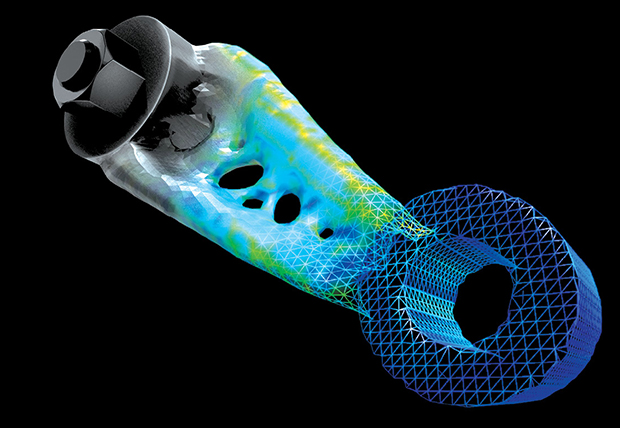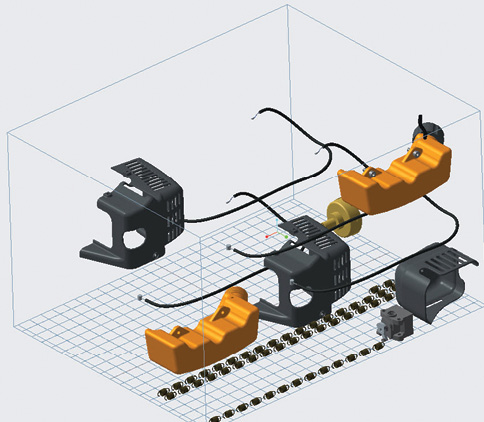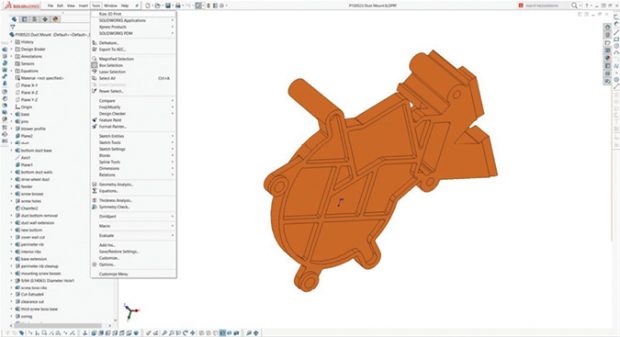Partnering on Design for Additive Manufacturing

Desktop Metal partnered with Dassault Systèmes on Live Parts, a generative design tool that aims to simplify design for additive manufacturing (DfAM). Image courtesy of Dassault Systèmes.
April 1, 2018
Evaluating designs with an eye toward organic shapes and lightweighting components; consolidating parts into streamlined assemblies; applying multimaterials at the voxel level to achieve optimal structural performance—these are some of the emerging principles defining a new age of design for additive manufacturing (DfAM). This new age is driven by less expensive and more accessible 3D printers and buffeted by new partnerships between 3D design software companies and 3D printing system manufacturers.
 Desktop Metal partnered with Dassault Systèmes on Live Parts, a generative design tool that aims to simplify design for additive manufacturing (DfAM). Image courtesy of Dassault Systèmes.
Desktop Metal partnered with Dassault Systèmes on Live Parts, a generative design tool that aims to simplify design for additive manufacturing (DfAM). Image courtesy of Dassault Systèmes.Digitalization, as part of the shift to smart factories or Industry 4.0, is escalating the use of 3D printing not just as a means for rapid prototyping but as an alternative for full-scale production. Companies are expanding use of additive manufacturing to garner cost efficiencies, promote mass customization strategies and to effectively produce organic shapes and lightweight structures that were simply not possible with traditional manufacturing methods like injection molding or CNC machining.
Yet for companies to fully reap the benefits of 3D printing, they need to do more than swap out traditional production processes as a means to output existing designs. Instead, experts say engineers need to take into account the unique properties and material options offered by additive manufacturing from the onset of the development process, in some cases changing the way they approach specific design challenges and following an emerging set of DfAM best practices.
“The frameworks and guidelines for what makes a successful design for injection molding or CNC machining are well established, but with 3D printing, you’re often using a design [conceived] for another process,” explains Mark Rushton, product portfolio manager for SOLIDWORKS at Dassault Systèmes. “People have operated with tribal knowledge, building up their own expertise on what works based on the materials and printers they have. It’s still very disjointed and based on so many variables that it’s difficult to establish a finite set of rules like you have with traditional manufacturing processes.”
A 3D Printing Backbone
To codify some of the practices and fuel momentum around 3D printing, 3D design software companies and 3D printer manufacturers are teaming up to empower new DfAM principles. Through partnerships and collaborative development initiatives, these players are extending their platforms with new capabilities and creating seamless workflows between 3D design and 3D printing software to promote DfAM practices early in the development effort as opposed to at the end of the cycle when it is more expensive to make adjustments, and when there is a greater risk of build failures.
“We want to let engineers take design considerations for AM into account inside of CAD,” explains Bryan Crutchfield, vice president and general manager for Materialise North America, which offers a range of 3D printing software and services, including Magics, a data preparation package and STL editor. “We are aiming to help design engineers understand that they can unlock all of this value with 3D printing and determine if a design is 3D printable before it goes to a printer.”
Materialise sees its role as a middleman of sorts, building out a backbone for 3D printing by forging partnerships with 3D software companies like PTC and Siemens PLM Software as well as with the leading 3D printer manufacturers, Crutchfield says. On the hardware side, the company has created build processor packages for most of the leading 3D printer OEMs, including for HP’s Jet Fusion 3200 and 4200 printers. These packages function as high-tech printer drivers allowing Materialise Magics—which aids in data preparation, production planning and machine control, along with other third-party applications—to take advantage of the highly advanced capabilities of individual machines (for example, zone-based slicing and hatching capabilities or specific material-based printing profiles).
“What this does is bring together a workflow from content creation all the way through manufacturing linked very tightly together,” Crutchfield says. “In this way, you can archive workflows, which prove you printed a product correctly,” a critical step, he explains, for highly regulated industries such as medical and dental applications.
 The Additive Manufacturing extension to Creo 4.0 allows for auto positioning and nesting of components in a “print tray” container, which can be reused and leveraged to save time and money. Image courtesy of PTC.
The Additive Manufacturing extension to Creo 4.0 allows for auto positioning and nesting of components in a “print tray” container, which can be reused and leveraged to save time and money. Image courtesy of PTC.On the software front, Materialise and Siemens PLM Software created a partnership last year to integrate Materialise Magics 3D Print Suite software directly into Siemens NX to streamline the design to manufacturing process. The solution seamlessly and associatively links NX with Materialise capabilities such as lattice generation, support structure design, 3D nesting and build tray preparation, eliminating the need for data translation and conversion. It also creates a single, smart model in NX 12 that can be output directly to a 3D printer such as HP’s Multi Jet Fusion offering. The company more recently joined hands with PTC to create a seamless connection between PTC’s Creo CAD software and 3D printing machines equipped with a Materialise Build Processor specifically in the area of metal 3D printing, enabling better control over the design and creation of metal support structures. These capabilities will be introduced with Creo 5.0 this spring.
Dassault Systèmes has a variety of partnerships with 3D printer manufacturers, including Stratasys, Desktop Metal, 3D Systems, Formlabs and Ultimaker, to create direct integrations between the hardware and its 3DEXPERIENCE platform, specifically CATIA and SOLIDWORKS. “The main challenge for design engineers is software integration,” says Rani Richardson, CATIA business experience consultant at Dassault Systèmes, explaining the firm’s strategy around collaboration. “Typically, multiple software tools are used to design, optimize and reconstruct surfaces, which makes for an error-prone and lengthy process for reconstructing the geometry after the model or assembly is optimized.”
Empowering DfAM Workflows
Siemens PLM Software is also pursuing a variety of partnerships and capabilities to streamline historically disconnected processes surrounding design and 3D printing to help avoid critical data loss and to capture knowledge of DfAM practices as they are learned, according to Aaron Frankel, the company’s senior director of product marketing. “If you have a lot of disconnected apps, you have to do a lot of rework, manage lots of different files and you can’t control processes—that’s not what you need in an industrial additive manufacturing system,” he explains.
One way Siemens PLM Software is streamlining DfAM processes is via its convergent modeling technology integrated in the NX product stack that melds traditional modeling capabilities with new generative design capabilities. The Parasolid-based convergent modeling functionality means users can leverage a seamless and unified set of modeling functions for classic detailed B-rep geometry or facet models, which are synonymous with additive manufacturing. This eliminates the need for data conversion and allows engineers to easily iterate and combine traditional models with the organic shapes being created through generative design and topology optimization tools, Frankel explains.
 The Rize add-in for SolidWorks automatically transfers files to the Rize slicing software for output on the printer without the need for file import or export. Image courtesy of Rize.
The Rize add-in for SolidWorks automatically transfers files to the Rize slicing software for output on the printer without the need for file import or export. Image courtesy of Rize.As part of that convergent modeling functionality, NX is now stacked with topology optimization capabilities that let an engineer establish constraints for weight, strength or cost, for example, and unleash the software to automatically calculate the optimal geometries for potential designs. In addition, NX 12’s convergent modeling technology, combined with its lattice structure functionality, enables engineers to create integrated structures that reduce component weight from within the familiar CAD environment, eliminating the need to employ a separate lattice design application. The NX environment has also been enhanced with new feature checking and validation capabilities to support the new DfAM tools and workflows, ensuring that resulting designs are viable prior to sending to a 3D printer for output.
“Making sure everything is linked together and that we provide a smooth end-to-end process is where we are focusing our development efforts,” says Jim Rusk, senior vice president and CTO for Siemens PLM Software.
Rize, a hybrid 3D printer manufacturer, says that its ability to meld fused filament fabrication (FFF) and piezo jetting technologies in a single print advances DfAM principles in the area of materials science to evolve designs, according to Andy Kalambi, the company’s CEO and president. Although traditional subtractive manufacturing processes like CNC machining limits designs by the materials used, AM eliminates some of those constraints. The Rize One hybrid 3D printer uses an augmented polymer deposition (APD) process that can simultaneously extrude a compound of engineering- and medical-grade thermoplastic and jet Release One inks to change material properties of the thermoplastic at a voxel level, producing both lightweight and high isotropic strength parts, Kalambi says. The Release One ink can also be used between the support structures and 3D printed part to ensure quick and easy removal, he explains.
In addition to introducing DfAM capabilities in SOLIDWORKS 2017 and 2018 (among them, generative design capabilities and check tools for flagging faces requiring supports or validating the viability of wall thicknesses), Dassault Systèmes has forged a number of partnerships aimed at seamlessly integrating 3D printing into the design workflow. At the SOLIDWORKS World 2018 conference in February, the company announced an alliance with HP to ensure its CAD and related design tools can take advantage of HP’s Multi Jet Fusion 3D printers’ voxel-level capabilities for lightweighting and optimizing designs using both color and DfAM principles around materials science. Both HP and Dassault Systèmes support the 3MF (3D Manufacturing Format) file format, a challenger to STL that can handle a richer data set, including color and materials. Nano Dimension, a solution for 3D printing electronics, also advanced DfAM practices in the area of materials science with its add-in for SOLIDWORKS that lets users combine conductive and insulating materials in a single 3D print on its DragonFly 2020 Pro unit.
At the same time, Dassault Systèmes also expanded its long-standing partnership with 3D Systems. Now, all SOLIDWORKS CAD subscription customers get free access to an integrated version of 3DXpert, 3D Systems’ tool for designing lattice and support structures and arranging the build platform. By integrating 3DXpert directly into the SOLIDWORKS workflow, Dassault Systèmes can offer designers an all-in-one solution as opposed to moving between multiple applications, Rushton explains. “Accessibility is key to everyone adopting AM,” he adds. “This gives our users the ability to try out the technology without having to make a big investment.”
At PTC, Creo 4.0 and the forthcoming Creo 5.0 are ushering in a host of new DfAM capabilities in the areas of creating lightweight structures, including parametrically controlled lattice parts; creating tray assemblies as a repository for storing AM information such as positions, materials and colors in the PLM systems; and improved integration between the CAD systems and 3D printers. Creo’s integrated finite element analysis simulation capabilities provide a single environment to analyze and optimize lattice structures and its print tray capabilities allow for the automatic positioning and nesting of models on a tray volume to optimize the build cycle, according to Jose Coronado, product manager, Creo Manufacturing and Simulation Applications, at PTC.
Although much has evolved on the DfAM front over the last few years, Coronado acknowledges there is more to be done and that’s why partnerships like the one with Materialise and 3D printer manufacturers are crucial. “The printers do more than we can model at this point,” Coronado says. “We need to be very close to the printer manufacturers in order to evolve our systems and close those gaps.”
More Info
Subscribe to our FREE magazine, FREE email newsletters or both!
About the Author
Beth Stackpole is a contributing editor to Digital Engineering. Send e-mail about this article to [email protected].
Follow DE





